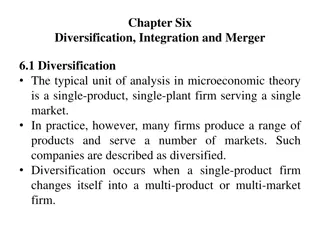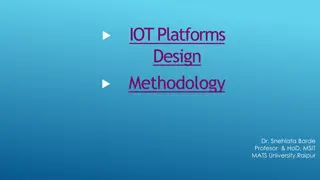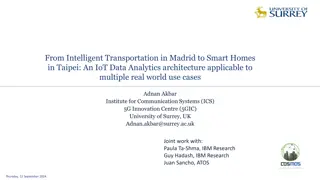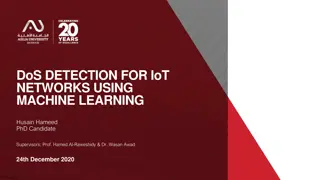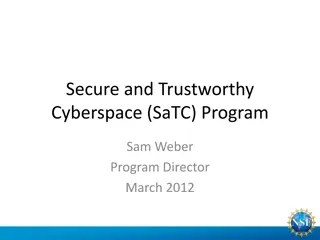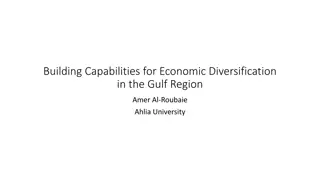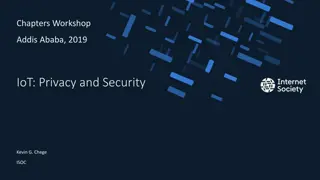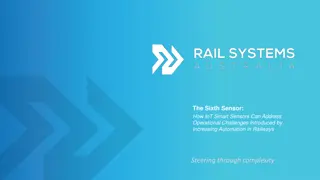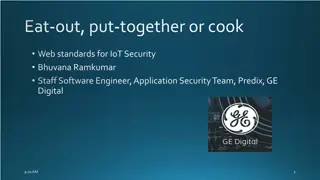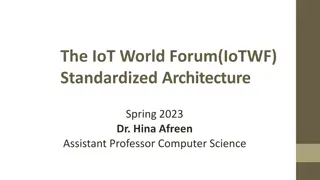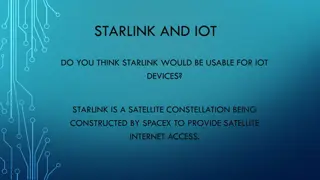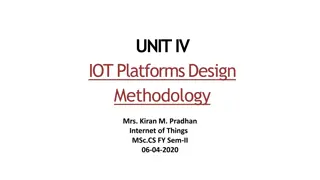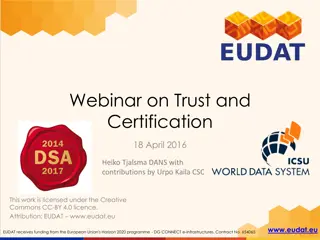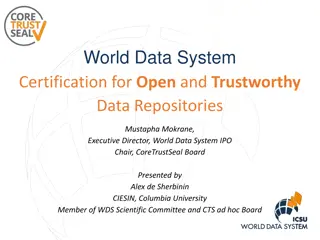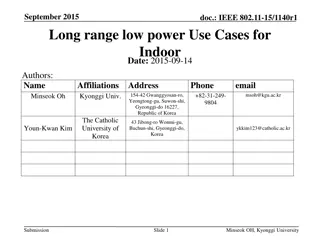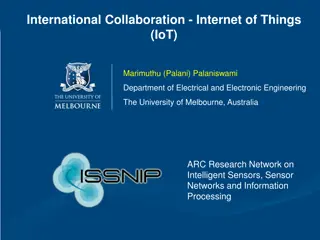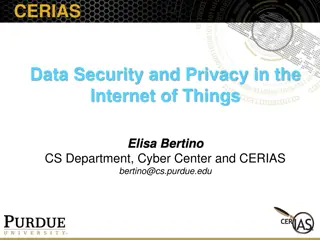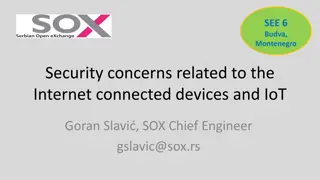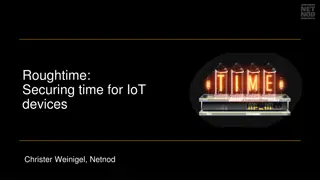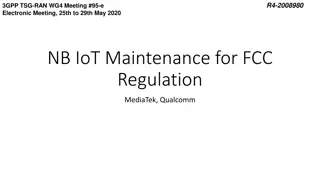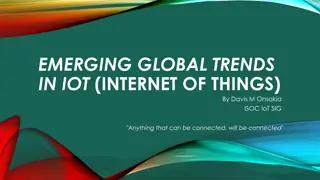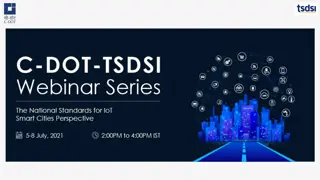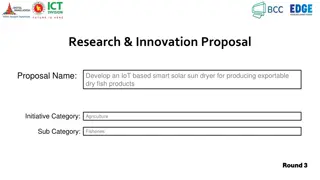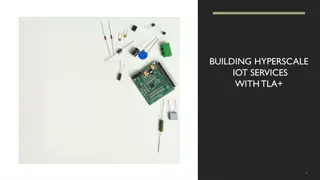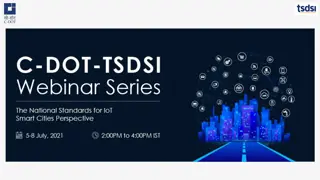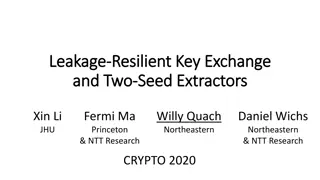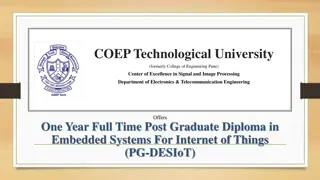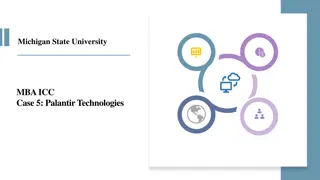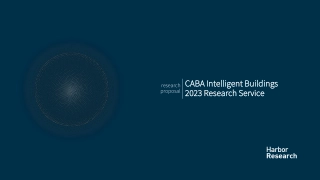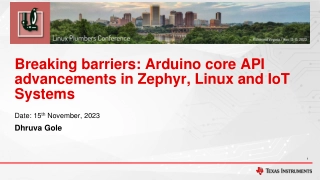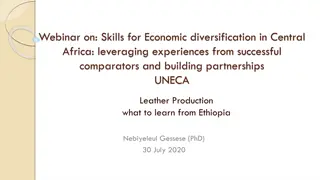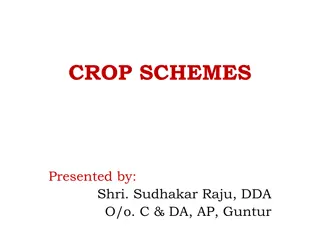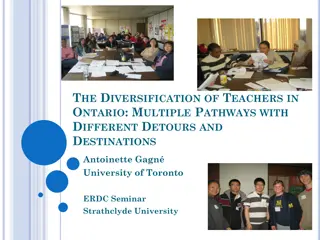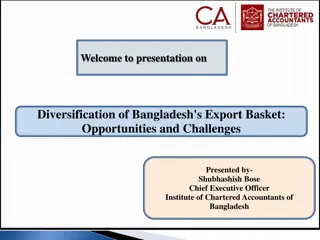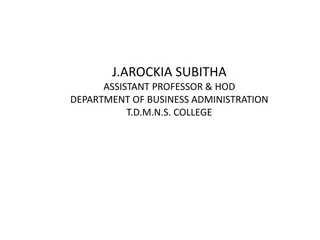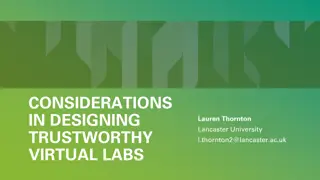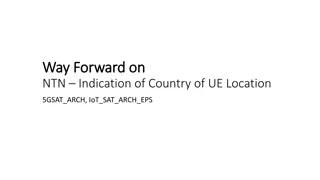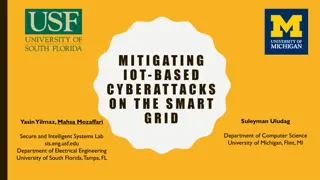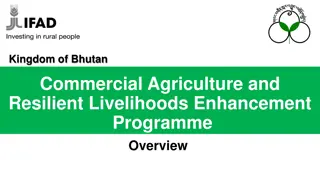Diversification for Resilient and Trustworthy IoT Systems
Recent research indicates that diversification is a key strategy for enhancing resilience in software systems, particularly in the context of IoT. By implementing diverse implementations for each instance of a service, systems can become more robust against cyber threats and attacks. This approach aims to make IoT systems more secure and trustworthy in the face of evolving cybersecurity challenges.
Download Presentation

Please find below an Image/Link to download the presentation.
The content on the website is provided AS IS for your information and personal use only. It may not be sold, licensed, or shared on other websites without obtaining consent from the author. Download presentation by click this link. If you encounter any issues during the download, it is possible that the publisher has removed the file from their server.
E N D
Presentation Transcript
DIVERSIFICATION FOR RESILIENT AND TRUSTWORTHY IOT-SYSTEMS Arnor Solberg
Agenda 12.00 Lunch (Arnor) 12.45 Report on work done during summer (Shukun) 13.00 Plans and status: (Arnor) 2
Outline Context and initial idea Baseline, Diversification in cloud context Diversify EU FET project DiversIoT overall objectives Phase 1 objectives, tasks, deliverables and planning Inputs to planning Letter and ESR from NFR NFR webinar Phase 1 report template 3
Context and initial idea In nature, diversity has been a key mechanism for resilience for all forms of life, by enabling them to adapt to changes in the environmental conditions and evolve immunity to perturbations. Want to avoid cases that if a system can break into one keyless car, it allows to steal any car that uses the same keyless system, (reported in R. Verdultet al., Dismantling Megamos Crypto:Wirelessly Lockpicking a Vehicle Immobilizer, i 22nd USENIX Security Symposium, 2015) Or break one BMW car system can break every BMW car system By 2020, more than 25% of the cyber attacks against enterprises will originate from the IoT. This is already a reality: 150,000 IP cameras running the same firmware and configuration (including default root/xc3511 credentials) were recently involved in the largest D-DoS attack until now, which blocked the Internet in North America for several hours, by sending debilitating levels of network traffic . Bilderesultat for wildlife http://www.gartner.com/newsroom/id/3291817 4
Context and initial idea Recent multidisciplinary research on software engineering and ecology suggests that a promising way to approach resilience in software systems is to diversify software 1. Laperdrix et al., Beauty and the Beast: Diverting modern web browsers to build unique browser fingerprints, i IEEE Symposium on Security and Privacy (S&P'16), 2016. 2. F. Fleurey et al., Multi-tier diversification in Web-based software applications, IEEE Software, 32 (1), pp. 83-90, 2015. 5
Context and initial idea Each instance of a service has a different implementation and operates differently, still ensuring that its global behavior is consistent and predictable. Thus, instead of exposing the very same code in millions of instances, each individual instance will be unique, making the overall system more resilient
Context and initial idea, Additional Diversity enablers 7
Context and initial idea Produce a set of diversified implementations for the service. Each service instance will be semantically equivalent to the intended service, but different instances will differ in particular by their: topology: e.g., the different components, and security mechanisms, can be distributed in multiple ways on the different nodes involved in an IoT service, and even the node topology can vary Intuitively, a very distributed topology will be more difficult to attack, as data is fragmented across multiple node but is communication-intensive, and thus less power efficient interface: e.g., diversification in terms of serialization (JSON, XML, binary etc), diversification in bit ordering, diversification in transport protocols (MQTT, UDP) coding: a given logical operation can be implemented in multiple ways. A simple example; 2 can indeed be represented as 2, or 1+1 or -2+3, etc. 8
DiversIoT The vision of this project is to make the IoT ecosystems resilient and trustworthy by diversifying IoT service implementations, enabling companies, public authorities and people to exploit and use IoT-based services, with low risk for privacy and security breaches and significantly reduced impact in case of cyber attack infringes Partners: SINTEF, UiO, and TellU 9
DiversIoT, main objectives Propose automated mechanisms to diversify IoT services, while preserving the specified behaviour Propose a diversified set of privacy and security mechanisms Enable continuous diagnosis and forensics of IoT systems 10
Phase 1 11
Goal Phase 1 Show the feasibility of the project's vision (software diversity-driven resilient and trustworthy IoT ecosystems) by demonstrating semi automatically-generated diversified IoT services, as a proof of concept to verify the idea and concept of DiversIoT and by surveying relevant approaches and technologies to clarify the unique contribution of DiversIoT and identify the baseline for the project. Moreover, a concrete plan for how to achieve scientific and industrial impact will be specified.
Secondary objectives Provide a survey of existing privacy and security mechanisms applicable to IoT ecosystems, in particular focusing on the resource-constrained end of the IoT (gateways and devices), as numerous and convincing solutions are already available for larger nodes (PCs, server, cloud). Provide a survey of diversity enablers applicable to IoT ecosystems able to yield technically and technologically diversified implementations of a given IoT service specification. Provide a Proof-of-Concept version of a diversified IoT service in the privacy- and security-demanding domain of eHealth, i.e., 5-10 semi-automatically diversified versions of a simple eHealth service involving a) a cloud back-end (TellU Cloud), b) a gateway, and c) a set of medical devices. Provide a concrete impact plan and initiate activities to ensure high impact of the project results, both in terms of industrial and scientific impact. 13
Main activities Phase 1 Main Activity 1: Diversity enablers for the IoT [UiO, SINTEF] During Phase 1, this activity will focus on surveying existing privacy and security mechanisms that can be adapted to the IoT and to the most resource-constrained node in particular (gateways, devices), as well as surveying other diversity enablers for the IoT e.g., different ways of implementing similar features, different way of communicating across nodes. The results of those two surveys will be delivered in D1.1 and D1.2. Main Activity 2: Automated Software Diversification for the IoT [SINTEF, TellU, UiO] During Phase 1, this activity will implement a family of 5-10 diversified services i.e., 5-10 different implementations of a given abstract eHealth service. This task will leverage on the existing capabilities of the ThingML language and compilers, as well as the knowledge acquired in FP7 FET Diversified to provide a semi-automatic way of deriving those 5-10 implementations from a common abstract specification of the service. This Proof-of-Concept of the DiversIoT idea will be delivered in D2.1. Main Activity 5: Interaction, Dissemination and Exploitation [SINTEF, UiO, TellU] During Phase 1, this activity will focus preparing the ground to ensure high impact of DiversIoT and make a concrete plan for dissemination and exploitation in terms of both academic and industrial impact. The impact plan and the report of current activities and achievements will be delivered in D5.0 in Phase 1. Main Activity 6: Management [SINTEF] This activity will be responsible for the proper management and follow-up of the above-mentioned tasks, and will be responsible for communications with the Research Council. This activity will also prepare a set of KPIs related to the general technical and non-technical requirements, use case requirements as well dissemination and exploitation. At the end of Phase 1 this will be delivered in a draft of D6.1. The final D6.1 will be delivered early in Phase 2. 14
Deliverables Phase 1 Two survey reports and one Proof-of-Concept demonstrator, reporting respectively on the three first secondary objectives described above. They are respectively delivered as deliverables D1.1, D1.2 and D2.1 at the end of Phase 1. A dissemination and exploitation plan and report on activities and achievements in Phase 1 to ensure high scientific and industrial impact of the project, in deliverable D5.0. In particular, a reference group, composed of industries and academics in Norway and abroad, will be established to ensure the interest and relevance of the project across academia and industry. SINTEF, UiO and TellU will leverage their networks to establish this group, e.g. by contacting Norge 6.0 (in particular involving Kongsberg Group, and FFI), NCE Smart Innovation stfold, the IoTSec community, as well as IoT service providers in TellUs customer and partnership portfolio (e.g,, Telenor and Prediktor). A project quality plan and a set of detailed KPIs (including KPIs related to ethnography) to ensure the proper management and smooth progress monitoring of Phase 2. This project quality plan will be delivered as D6.1 at the beginning of Phase 2, but a coherent draft will be available at the end of Phase 1. Detailed PhD/PostDoc topics are prepared, and potential candidates have been identified. The positions are ready to be advertised as soon as Phase 2 funding is decided. Topics will be presented at the review at the end of Phase 15
SINTEF SINTEF is conducting the project management and is responsible for Main Activities 2, 5 and 6, all starting in Phase 1. SINTEF Digital and the group for Smart IoT Systems brings expertise in Software Engineering and IoT. In particular, it has developed the ThingML approach, a modelling language together with a code generation framework, supporting the design and implementation of IoT services on top of heterogeneous platforms. This group at SINTEF has also been involved in EU-FET Diversify project, investigating future technologies for embedding diversity for resilient software systems in collaboration with biology scientists. ThingML and expertise in software diversity will be two key pillars for this project enabling a rapid kick-starting of Main Activities 1 and 2 during Phase 1. In phase 1, SINTEF will also lead Main Activity 5 and the impact planing, UiO and TellU will also provide significant contribution to this activity.
Responsible for Main Activities 1. UiO will be represented by the Institute for Informatics (IFI) and Institute for Technology Systems (UNIK). UiO will bring expertise on IoT in general and security for IoT in particular. This expertise in IoT security is another key pillar for this project and for the proper execution of Main Activity 1. In Phase 1 the focus of the Main Activity 1 is to do technology surveys. 18
TellU: TellU is a spinoff from Ericsson Reasearch funded in 2006 and develops and delivers services and software through TelluCloud, an IoT platform for data gathering, processing and presentation. Their markets are in the domains of assisted living, e-health and personnel safety. A main business for TellU is to deliver eHealth and welfare services for the public and home care market in Norway, they also have services for personnel security in particular through a Dutch partner During Phase 1, TellU, as a end user representative, will provide requirements, use cases and KPIs for the project and will take part in the impact preparations and planning. 19
Specific plans SINTEF Describe the concrete Proof of concept scenarios (exploiting the HEADS Tellu Case) Use case scenario and technology stack What to diversify (code, communication, and/or (probably not) deployment structure..) What are the challenges Initial ideas of how to solve Prove consistent behavior Survey on Diversity Enabler (as a feature diagram) Code, (with languages) Communication Network protocols Deployment structures Platforms Security mechanisms and protocols 20
Papers Survey paper on security Mechansims (UiO) Other papers from UiO related to IoT sec (acknowledging DiversIoT) Diversify paper with INRIA and Franck F Position paper (ICSE NIER) (SINTEF) based on: Proposal Proof of concept implementation/scenario Diversity Enablers (Feature tree) Popular Science paper based on Proposal + application domains Arnor contact Gemini to ask how this may be done 21
Other Dissemination activities IoT Gemini centre (kick off 28/8) DiversIoT workshop in Sweden (UiO) Web site (UiO) IoT Sec (UiO) Seminar at UiO in May 22
Notes Make a clear targeted dissemination/communication from what we do to who should be interested Ethnography: People that think differently (put these in the reference group, e.g., datatilsynet, forbrukerr det, users ) 2,1 Million homes times number of devices (30-200), which can easily DoS any IP-service, Mondragon university (in Spain) Figua Master working with diversification of security, authentication, authorization mechanisms 23
Context, Gemini Centre on IoT A Gemini centre is a centre/network of science excellence. The Gemini Centre will be exploited to impact development and innovations in Norwegian industry and society as well as excellence in science. UiO, NTNU and SINTEF are partners in this centre. SINTEF is leading SINTEF 10 forskere (1 sjefsforsker, 7 seniorforskere, 2 forskere) UiO, 5 professorer, 5 PhD kandidater, 4 post doc og forskere NTNU, 9 professorer og f rsteamanuensis, 5 PhD kandidater, 4 post doc og forskere DiversIoT is one of the project that will be coupled to this centre 24
Specific concerns to address in Phase 1 report See letter + ESR 25
END 26


